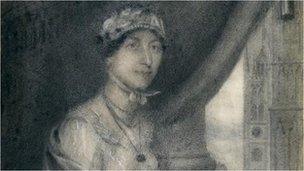Jane Austen to be face of the Bank of England £10 note
- Published
- comments
People from Jane Austen's hometown of Alton give their views on the note
Author Jane Austen is to feature on the next £10 note, the Bank of England says, avoiding a long-term absence of women represented on banknotes.
The Pride and Prejudice author will be the next face of the note, replacing Charles Darwin, probably in 2017.
Chancellor George Osborne tweeted, external the move showed "sense and sensibility".
In April, the Bank prompted a high-profile campaign against the prospect of having no female characters, besides the Queen, on the UK's currency.
It had announced that Sir Winston Churchill would be put on the £5 note from 2016, replacing social reformer Elizabeth Fry.
The latest announcement means that women could be absent from newly issued banknotes for up to a year, although the Elizabeth Fry £5 note will still be in circulation.
'In the wings'
On Twitter, Mr Osborne wrote: "[Incoming Bank of England governor] Mark Carney's choice of Jane Austen as face of £10 note is great. After understandable row over lack of women, shows sense and sensibility."
Banknotes are regularly redesigned, in order to maintain security and prevent forgeries.
The most recent new design from the Bank of England to enter circulation was the £50 note. This features Matthew Boulton and James Watt, who were most celebrated for bringing the steam engine into the textile manufacturing process.
The decision to replace Elizabeth Fry on the £5 note prompted protests and discussions about female representation on banknotes, but Jane Austen was thought to have already been part of the Bank's plans for the next new note.
Sir Mervyn King, in his last public appearance as governor of the Bank, said the author was "quietly waiting in the wings" to replace Darwin.
Mr Carney started discussions about female representation on banknotes on his first day in office.
Mark Carney discusses women on bank notes and in the Bank of England
The Bank said in a statement that it was "never the Bank's intention" that none of the four characters on banknotes would be a woman.
"Jane Austen certainly merits a place in the select group of historical figures to appear on our banknotes. Her novels have an enduring and universal appeal and she is recognised as one of the greatest writers in English literature," Mr Carney said.
He also announced a review of the selection process for future banknote characters. Jane Austen will be the 17th historical figure to appear on Bank of England notes. The review will be completed by the end of the year.
Campaign
The pressure was increased on the new governor through protests, an online petition - signed by 35,000 people, and a threat of legal action.

Caroline Criado-Perez led a campaign for more female representation on banknotes
The campaign was led by Caroline Criado-Perez, from Rutland, who was invited to speak to Bank officials about the situation earlier in July.
She described the expected announcement as "a brilliant day for women and a fantastic one for people power".
"We warmly welcome this move from the Bank and thank them for listening to us and taking such positive and emphatic steps to address our concerns," she said.
"To hear Jane Austen confirmed is fantastic, but to hear the process will be comprehensively reviewed is even better.
The money raised for a legal challenge will now be donated to women's charities the Fawcett Society, Women's Aid and Rape Crisis.
Banknote features
Jane Austen, who lived from 1775 to 1817, became one of the country's most celebrated novelists. She was born in Hampshire as one of eight children.

Jane Austen is one of the country's most celebrated authors. She died in 1817
She began to write as a teenager. Her first novel, Sense and Sensibility, appeared in 1811. She described her next novel, Pride and Prejudice, as her "own darling child".
Her other published novels were Mansfield Park, Emma, Persuasion and Northanger Abbey - the final two of which were published after her death.
Most of her novels were published anonymously.
The portrait of Jane Austen, which will appear on the banknote, is adapted from a sketch drawn by her sister Cassandra Austen. Other features include:
A quote from Pride and Prejudice - "I declare after all there is no enjoyment like reading!"
An illustration of Elizabeth Bennet, one of the characters in Pride and Prejudice
An image of Godmersham Park in Kent - the home of Jane Austen's brother, Edward Austen Knight, and the inspiration for a number of novels
A central background design of the author's writing table which she used at home at Chawton Cottage in Hampshire
Fellow writers William Shakespeare and Charles Dickens have appeared on banknotes in recent times. Dickens was on the £10 note and Shakespeare on the £20 note.
Bank of England notes can be spent throughout the UK. In addition, three banks in Scotland and four in Northern Ireland are authorised to issue banknotes.
- Published3 July 2013
- Published26 April 2013
- Published24 June 2013
- Published18 July 2012
- Published2 November 2011